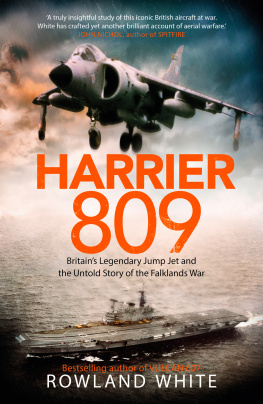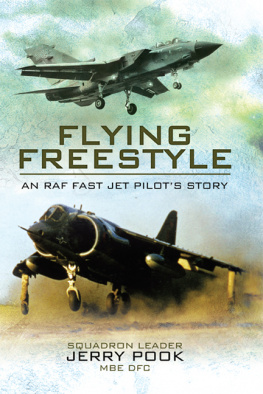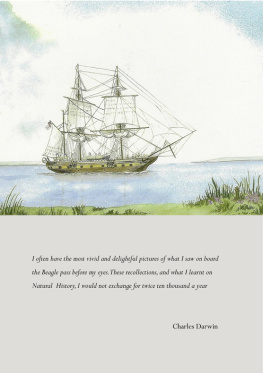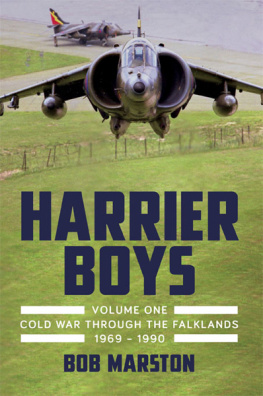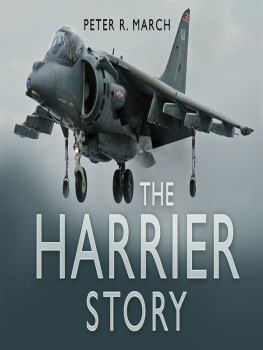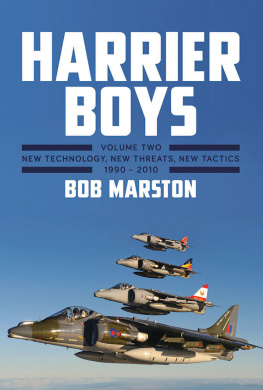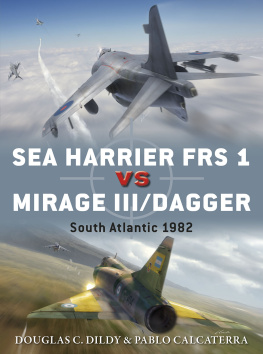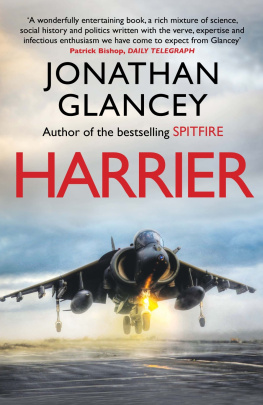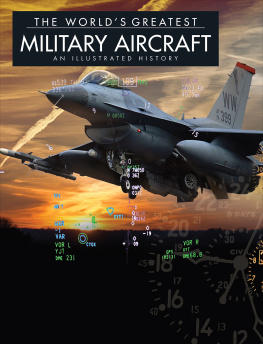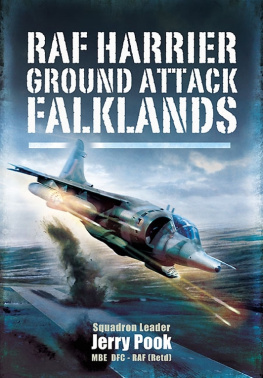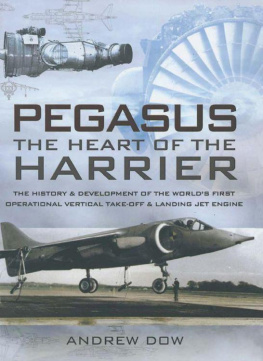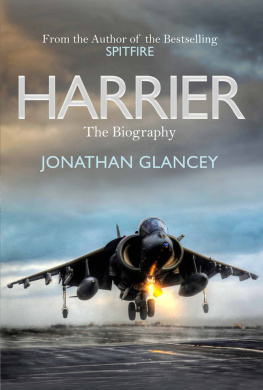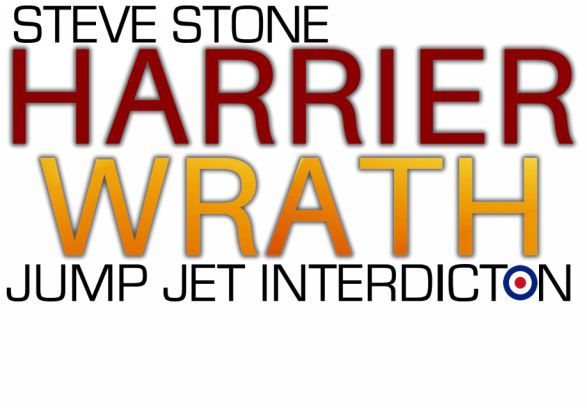
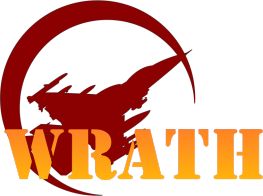
Steve Stone 2015
Steve Stone has asserted his rights under the Copyright, Design and Patents Act, 1988, to be identified as the author of this work.
Published by Digital Dream Publishing 2015

Contents
FOREWARD
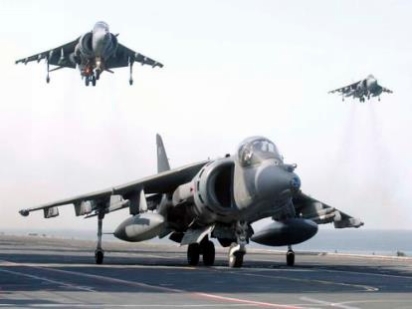
The Harrier has a unique place in aviation history as the most successful VTOL aircraft to date. Such was its success that it was also built under licence in America by McDonnell Douglas (now Boeing) and the Americans along with the British aided in improving it for both later American (AV-8B) and British (GR5, GR7, GR9) versions. It has fought in several theatres including the Falklands, former Yugoslavia, Iraq and Afgahnistan. Now retired from British service, it is still very much active with the U.S Marine Corps until ultimately being replaced by the Lockheed Martin F-35B STOVL (short takeoff and vertical landing). The F-35B will start to replace the AV-8B in 2016, but the AV-8B will continue in service until 2025. Meanwhile, the AV-8B will receive revamped defensive measures, updated data-link capability and targeting sensors, and improved missiles, among other enhancements. This unique book looks not only at the history but follows Harrier GR9A ZG477 into active duty in Afghanistan fighting a deadly foe. It also covers the American AV-8B in action in Iraq and Sea Harrier in the Falklands War.
***
To have the versatility of a helicopter and performance of a high speed aircraft, is something designers strived for in the early days of aviation. Various designs were tried and failed. From aircraft that took off vertically powered by large propellers to tilt wings, tilt engines, fans in the wings, augmented engines to name a few. The Harrier was in essence born out of research undertaken with the Rolls Royce developed Thrust Measuring Rig (TMR) also known Flying Bedsted. The Flying Bedstead powered by two Nene turbojets was a pioneering vertical take-off and landing aircraft that first flew in the 1953. The TMR was made up from steel framework with four legs with castors for wheels and used two Nene engines mounted back-to-back horizontally. It proved that stable hovering was possible from a jet engine and paved the way for the Harriers control system. From the TMR, this led to the Rolls Royce RB108 and the Short SC.1. The SC.1 flew for over ten years, providing a large amount of data that influenced later design concepts such as the "puffer jet" controls on the Hawker Siddeley P.1127, which would later evolve into the Hawker Siddeley Harrier. The US Navy funded the Lockheed XFV-1 and Convair XFY-1 turboprop with tests ceasing in 1956. A third aircraft that took off from its tail, known as a tailsitter, the Ryan X-13 Vertijet, was powered by a Rolls Royce Avon turbojet. The X13 became the worlds first jet powered VTOL research aircraft when it flew on 10 December 1955. The Bell X-14 got closer to the Harrier with its vectored thrust engine which first flew in 1957 and went from horizontal to vertical flight on 24 May 1958. However, by 1964 the USAF stuck with the view that V/STOL was not worthwhile and the expectation was the F-111 would sell around the world as a next generation aircraft, effectively holding back V/STOL aircraft development.
The requirement for combat that could be dispersed away from main air bases arose in the early days of the Cold War. As the West fears grew that the Soviet Union would soon possess thousands of nuclear weapons which could potentially wipe out conventional air bases. The big issue with V/STOL aircraft was their cost compared to conventional designs. Another issue was having a powerplant with a much higher than normal thrust to weight ratio.
The key to the Harriers design is the Bristol Pegasus Vectored engine, which would have not existed, but for the Harrier and vice versa. The engine was first proven in the P.1127. Sir Sydney Camm and Bristols Sir Stanley Hooker got the P.1127 in the air 17 months after cutting the first piece of metal. The design and abilities of the early Harriers were enough to get the interest of the USA and work in partnership with McDonnell Douglas, now Boeing in the design and development of the US built AV8A and AV8B.
The Hawker Siddeley Harrier GR1/GR3 and the AV8A were the first generation of Harrier. They were the first operational close support and reconnaissance attack aircraft with vertical/short takeoff and landing (V/STOL) capabilities. These were developed directly from the Hawker P.1127 prototype and the Kestrel evaluation aircraft. Kestrel development began in 1957, taking advantage of the Bristol Engine Company's choice to invest in the creation of the Pegasus vectored-thrust engine. Testing began in July 1960 and by the end of the year the aircraft had achieved both vertical take-off and horizontal flight. The test program also explored the possibility of use upon aircraft carriers, landing on HMS Ark Royal in 1963. The first three aircraft crashed during testing, one at the 1963 Paris Air Show. The RAF went on to order the Harrier GR1 and GR3 variants in the late 1960s.The Harrier GR.1 made its first flight on 28 December 1967. Officially entered service with the RAF on 18 April 1969. The GR3 was an upgrade to the GR1 with improved sensors, a nose-mounted laser tracker, the integration of ECM systems and a further upgraded Pegasus 11 or Mk 103 with 21,000 lbf up from the original 19,000 lbf of thrust on the first GR1s. Which was quite a leap from the P.1127 prototype which had only 13,500 lbf of thrust.
The Sea Harrier was the naval version of the Hawker Siddeley Harrier. It was designed as a V/STOL jet fighter, reconnaissance and attack aircraft. The first version entered service with the Royal Navy's Fleet Air Arm in April 1980 as the Sea Harrier FRS1, and was informally known as the Shar. The upgraded Sea Harrier FA2 entered service in 1993. It was withdrawn from Royal Navy service in March 2006, when the cost of upgrading it to the GR9 standard was too costly. The Royal Navy gained use of the GR7/GR9 until the harriers retirement. The Sea Harrier FRS Mk51 is still in active service with the Indian Navy, which operates the jet from its aircraft carrier INS Viraat.
The Harrier II which followed the US AV8A and RAF GR3 was extensively redeveloped by McDonnell Douglas and British Aerospace leading to the Boeing/BAE Systems AV8B Harrier II. This second-generation V/STOL jet multi-role aircraft, including the British Aerospace-built Harrier GR5/GR7/GR9, which entered service in the mid-1980s. The AV8B is primarily used for light attack or multi-role tasks, typically operated from small aircraft carriers. Versions are used by several NATO countries, including Spain, Italy, and the United States. The Harrier II was an extensively modified version of the first generation Harrier. The original aluminium alloy fuselage was replaced by a fuselage which made extensive use of composites, providing significant weight reduction and increased payload or range. A new one-piece wing provided around 14 per cent more area and increased thickness. The wing and leading-edge root extensions allowed for a 6,700-pound payload increase over a 1,000 ft takeoff compared with the first generation Harriers. The Harrier IIs also had an additional missile pylon in front of each wing landing gear, and strengthened leading edges of the wings to meet higher bird strike requirements. Avionics were upgraded and a bubble canopy added to improve visibility along with a hands-on-throttle-and-stick system (HOTAS) to help make the Harrier II easier to fly.
Next page







